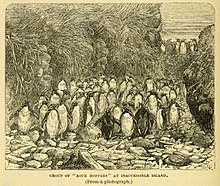Northern rockhopper penguin
| Northern rockhopper penguin | |
|---|---|

| |
| At Berlin Zoological Garden, Germany | |
| Scientific classification | |
| Kingdom: | |
| Phylum: | |
| Class: | |
| Order: | |
| Family: | |
| Genus: | |
| Species: | E. moseleyi
|
| Binomial name | |
| Eudyptes moseleyi | |
The northern rockhopper penguin, Eudyptes c. moseleyi, is usually considered a subspecies of rockhopper penguin, although fairly recent studies show evidence of distinction from the southern rockhopper penguin group Eudyptes c. chrysocome/E. c. filholi.
A study published in 2009 showed that the population of the northern rockhopper had declined by 90% since the 1950s. For this reason, the northern rockhopper penguin is classified as endangered.
Taxonomy
The rockhopper penguins have been considered to consist of two species, northern and southern rockhopper penguin, since research published in 2006 demonstrated morphological, vocal, and genetic differences between the two populations.[2][3] Molecular datings suggest that the genetic divergence with the southern rockhopper penguin may have been caused by a vicariant event caused by a shift in the position of the Subtropical Front during the mid-Pleistocene climate transition.[4] Analysis of a part of a mitochondrial control region from a northern rockhopper penguin found on the Kerguelen Islands showed that it may have come from Gough Island, 6,000 km away, and that the southern and northern rockhoppers are genetically separate, though some individuals may disperse from their breeding colonies.[5] Many taxonomists have yet to recognize the split, although some are beginning to do so.
Distribution and habitat
More than 99% of northern rockhoppers breed on Tristan da Cunha and Gough Island in the south Atlantic Ocean.[6]
Ecology and behaviour
Food and feeding
The northern rockhopper penguin feeds on krill and other sea life such as crustaceans, squid, octopus and fish.[6]
Breeding
It breeds in colonies in a range of locations from sea level or on cliff sides, to sometimes inland.[6]
Population and threats

The current population is estimated to be between 100,000–499,999 breeding pairs at Gough Island, 18,000 to 27,000 pairs at Inaccessible Island, and 3,200 to 4,500 at Tristan da Cunha. In the Indian Ocean, the population was 25,500 pairs on Amsterdam Island, and 9,000 pairs on St Paul Island in 1993; there has been no information available on population trends there since the 1990s. Declines at the Atlantic Ocean sites show a decline of 2.7% per year;[6] the drop in the population at Gough Island has been described as equivalent to the loss of 100 birds every day since the 1950s.[7]
A study published in 2009 showed that the world population of the northern rockhopper had declined by 90% since the 1950s, possibly because of climate change, changes in marine ecosystems and overfishing for squid and octopus by humans.[8] Other possible factors in the decline include disturbance and pollution from ecotourism and fishing, egg-harvesting, predation from introduced house mice (Mus musculus) and predation and competition from subantarctic fur seals (Arctocephalus tropicalis).[6]
The northern rockhopper penguin is classified as endangered because of the decline in numbers over the last three generations (or 30 years).[6]
2011 oil spill
On March 16, 2011, the Maltese-registered freighter MS Oliva ran aground on Nightingale Island, spilling tons of heavy crude into the ocean. The crew was rescued, but the ship broke up, leaving an oil slick that surrounded the island, threatening its population of rockhopper penguins.[9][10] Nightingale Island has no fresh water, so the penguins were transported to Tristan da Cunha for cleaning.[11]
In culture
- Cody Maverick, a seventeen-year-old northern rockhopper penguin, the main protagonist in the 2007 film Surf's Up.[12]
- Secret Agent Buck Rockgut, a northern rockhopper penguin, appeared in three episodes of The Penguins of Madagascar[citation needed]
- In the Happy Feet and Happy Feet Two films, the Barry White-like love guru, Lovelace, is a rockhopper penguin, who will instil his wisdom for the price of rocks. Lovelace is voiced by Robin Williams.[citation needed]
- Of the Penguin Palooza mascots for the Newport Aquarium, in Kentucky, United States, Rocky is a northern rockhopper penguin.[citation needed]
References
- ^ Template:IUCN
- ^ Jouventin P., Cuthbert R.J., Ottvall R. (2006). Genetic isolation and divergence in sexual traits: evidence for the Northern Rockhopper Penguin Eudyptes moseleyi being a sibling species. Molecular Ecology 15:3413-3423.
- ^ Banks J., Van Buren A., Cherel Y., Whitfield J.B. (2006). Genetic evidence for three species of Rockhopper Penguins, Eudyptes chrysocome. Polar Biology 30:61-67.
- ^ de Dinechin, M., Ottvall R., Quillfeldt P. & Jouventin P. (2009). Speciation chronology of northern rockhopper penguins inferred from molecular, geological and palaeoceanographic data. Journal of Biogeography 36(4):693–702.
- ^ de Dinechin M., Pincemy G., Jouventin P. (2007) A northern rockhopper penguin unveils dispersion pathways in the Southern Ocean Polar Biology 31(1):113-115
- ^ a b c d e f BirdLife International (2008). Species factsheet: Eudyptes moseleyi. Retrieved 16 January 2009.
- ^ msnbc.com. Northern rockhopper penguins near extinction. 16 January 2009. Retrieved 18 March 2009.
- ^ BirdLife International. Penguins are walking an increasingly rocky road. 16 January 2009. Retrieved 16 January 2009.
- ^ "MS Oliva runs aground on Nightingale Island". The Tristan da Cunha Website. Retrieved 23 March 2011.
- ^ "Oil Spill Menaces Penguins". Science. 331: 1499. 25 March 2011. doi:10.1126/science.331.6024.1499-b.
- ^ BBC News Oil-soaked rockhopper penguins in rehabilitation
- ^ Surf's Up at IMDb

